Which Painting Would Be Considered a Milestone in the Development of Modern Art?
An art movement is a tendency or fashion in art with a specific common philosophy or goal, followed by a group of artists during a specific period of fourth dimension, (usually a few months, years or decades) or, at least, with the heyday of the movement divers inside a number of years. Art movements were especially important in modern art, when each consecutive movement was considered as a new advanced motion.
Concept [edit]
Co-ordinate to theories associated with modernism and the concept of postmodernism, art movements are peculiarly of import during the menstruum of time corresponding to mod art.[one] The period of fourth dimension called "modern art" is posited to have changed approximately halfway through the 20th century and art made afterward is generally called contemporary art. Postmodernism in visual art begins and functions as a parallel to tardily modernism[2] and refers to that period later on the "modern" menstruum called contemporary art.[iii] The postmodern menses began during belatedly modernism (which is a gimmicky continuation of modernism), and according to some theorists postmodernism ended in the 21st century.[4] [five] During the period of time corresponding to "modern fine art" each consecutive motility was oftentimes considered a new advanced.[4]
Also during the period of time referred to as "modern fine art" each movement was seen corresponding to a somewhat grandiose rethinking of all that came before it, apropos the visual arts. More often than not at that place was a commonality of visual fashion linking the works and artists included in an fine art movement. Verbal expression and caption of movements has come from the artists themselves, sometimes in the form of an art manifesto,[vi] [7] and sometimes from art critics and others who may explain their agreement of the meaning of the new art then existence produced.
In the visual arts, many artists, theorists, fine art critics, art collectors, art dealers and others mindful of the unbroken continuation of modernism and the continuation of modern art even into the contemporary era, accredit to and welcome new philosophies of fine art equally they appear.[8] [9] Postmodernist theorists posit that the idea of art movements are no longer as applicable, or no longer as discernible, as the notion of fine art movements had been before the postmodern era.[10] [11] In that location are many theorists still who doubt equally to whether or not such an era was actually a fact;[4] or but a passing fad.[v] [12]
The term refers to tendencies in visual art, novel ideas and architecture, and sometimes literature. In music it is more mutual to speak nigh genres and styles instead. See besides cultural movement, a term with a broader connotation.
Equally the names of many art movements use the -ism suffix (for example cubism and futurism), they are sometimes referred to every bit isms.
19th century [edit]
- Bookish, c. 16th century–20th century
- Aesthetic Move
- American Barbizon school
- American Impressionism
- Amsterdam Impressionism
- Art Nouveau, c. 1890–1910
- Arts and crafts Move, founded 1860s
- Barbizon schoolhouse, c. 1830s–1870s
- Biedermeier, c. 1815–1848
- Cloisonnism, c. 1888–1900s (decade)
- Danish Golden Historic period c. 1800s-1850s
- Decadent move
- Divisionism, c. 1880s–1910s
- Düsseldorf Schoolhouse
- Etching revival
- Expressionism, c. 1890s–1930s
- German Romanticism, c. 1790s–1850s
- Gründerzeit
- Hague Schoolhouse, c. 1860s–1890s
- Heidelberg School, c. 1880s–1900s (decade)
- Hoosier Group
- Hudson River School, c. 1820s–1900s (decade)
- Hurufiyya movement mid-20th-century in North Africa and the Middle East
- Impressionism, c. 1860s–1920s
- Incoherents, c. 1882-1890s
- Jugendstil
- Les Nabis, c. 1890s–1900s (decade)
- Les Vingt
- Letras y figuras, c. 1845-1900s
- Luminism
- Lyon School
- Macchiaioli c. 1850s–1900s (decade)
- Mir iskusstva, founded 1898
- Modernism, c. 1860s-ongoing
- Naturalism
- Nazarene, c. 1810s–1830
- Neo-Classicism, c. 1780s–1900s (decade)
- Neo-impressionism, c. 1880s–1910s
- Norwegian romantic nationalism, c. 1840–1867
- Norwich School, founded 1803
- Orientalism
- Peredvizhniki
- Pointillism, c. 1880s–1910s
- Pont-Aven School, c. 1850s–1890s
- Post-Impressionism, c. 1880s–1900s (decade)
- Pre-Raphaelite Brotherhood
- Realism, c. 1850s–1900s (decade)
- Realism, c. 1850s–1900s (decade)
- Romanticism, c. 1750s–1890s
- Secession groups, c. 1890s–1910s
- Order of American Artists, c. 1877–1906
- Spanish Eclecticism, c. 1845-1890s
- Symbolism
- Synthetism, c. 1877–1900s (decade)
- Tipos del País
- Tonalism, c. 1880–1915
- Vienna Secession, founded 1897
- Volcano School
- White Mountain fine art, c. 1820s–1870s
- Spiritualist art, c. 1870–
20th century [edit]
1900–1921 [edit]
- Academic, c. 1900s (decade)-ongoing
- American realism, c. 1890s–1920s
- Analytic Cubism, c. 1909–1912
- Art Deco, c. 1910–1939
- Ashcan School, c. 1890s–1920s
- Australian tonalism, c. 1910s–1930s
- Berliner Sezession, founded 1898
- Bloomsbury Group, c. 1900s (decade)–1960s
- Brandywine Schoolhouse
- Camden Town Group, c. 1911–1913
- Constructivism, c. 1920–1922, 1920s–1940s
- Cubism, c. 1906–1919
- Cubo-Futurism, c. 1912–1918
- Czech Cubism, c. 1910–1914
- Dada, c. 1916–1922
- Der Blaue Reiter, c. 1911–1914
- De Stijl, c. 1917–1931
- Deutscher Werkbund, founded 1907
- Die Brücke, founded 1905
- Expressionism c. 1890s–1930s
- Fauvism, c. 1900–1910
- Futurism, c. 1909–1916
- German Expressionism, c. 1913–1930
- Group of 7 (Canada), c. 1913–1930s
- Jack of Diamonds, founded 1909
- Luminism (Impressionism), c. 1900s (decade)–1930s
- Modernism, c. 1860s–ongoing
- Neo-Classicism, c. 1900s (decade)–ongoing
- Neo-primitivism, from 1913
- Neue Künstlervereinigung München
- Novembergruppe, founded 1918
- Objective Abstraction, c. 1933–1936
- Orphism, c. 1910–1913
- Photo-Secession, founded c. 1902
- Pittura Metafisica, c. 1911–1920
- Proto-Cubism, c. 1906–1908
- Purism, c. 1917–1930s
- Rayonism
- Section d'Or, c. 1912–1914
- Suprematism, formed c. 1915–1916
- Synchromism, founded 1912
- Synthetic Cubism, c. 1912–1919
- The Eight, c. 1909–1918
- The Ten, c. 1897–1920
- Vorticism, founded 1914
1920–1945 [edit]
- American Scene painting, c. 1920s–1950s
- Arbeitsrat für Kunst
- Fine art Deco
- Bauhaus, c. 1919–1933
- Physical art
- Der Ring
- De Stijl, c. 1917–1931
- Ecole de Paris
- Geometric abstraction
- Gruppo seven
- International Fashion, c. 1920s–1970s
- Kapists, c. 1930s
- Magic Realism
- Neo-Romanticism
- Neue Sachlichkeit
- Novecento Italiano
- Novembergruppe, founded 1918
- Precisionism, c. 1918–1940s
- Regionalism (art), c. 1930s–1940s
- Render to order, 1918–1922
- Scuola Romana, c. 1928–1945
- Social Realism, c. 1920s–1960s
- Socialist Realism
- Surrealism, c. 1920s–1960s
- Universal Constructivism, c. 1930–1970
1940–1965 [edit]

- Abstract expressionism
- Action painting
- Arte Povera
- Art Informel
- Assemblage
- Beatnik art
- Chicago Imagists
- CoBrA, c. 1948–1951
- Color Field painting
- Combine painting
- De-collage
- Fluxus
- Happening
- Hard-Edge Painting
- Kinetic Art
- Kitchen Sink Schoolhouse
- Lettrism
- Lyrical brainchild
- Neo-Dada
- New Brutalism
- Northwest Schoolhouse
- Nouveau Réalisme
- Op Art
- Organic brainchild
- Outsider Art
- Panic Motion
- Popular Art
- Post-painterly abstraction
- Process art
- Public art
- Retro art
- Serial art
- Shaped canvas
- Situationist International
- Tachism
- Video fine art
1965–2000 [edit]
- Abstract Illusionism
- Appropriation
- Arte Povera
- Art Photography
- Body Art
- Classical Realism
- Conceptual Art
- Dogme 95
- Earth Art
- Figuration Libre
- Funk fine art
- Graffiti fine art
- Hyperrealism
- Installation art
- Internet Art
- Land art
- Belatedly modernism
- Light and Space
- Lowbrow
- Lyrical Abstraction
- Postal service art
- Massurrealism
- Maximalism
- Minimalism
- Neo-Expressionism
- Neo-figurative
- Neo-popular
- Functioning Art
- Postminimalism
- Postmodernism
- Photorealism
- Psychedelic art
- Relational art
- Site-specific art
- Sound Art
- Transavanguardia
- Immature British Artists
21st century [edit]
- Algorithmic art
- Altermodernism
- Biomorphism
- Computer art
- Computer graphics
- Craftivism
- Digital art
- Electronic Art
- Ecology art
- Excessivism
- Intentism
- Net art
- Intervention art
- Metamodernism
- Modern European ink painting
- Neo-minimalism
- New Media Art
- Pixel art
- Post-postmodernism
- Relational art
- Remodernism
- Social practise (art)
- SoFlo Superflat
- Stuckism International
- Superflat
- Superstroke
- Transgressive fine art
- Toyism
- Unilalianism
- Vaporwave
- Postinternet
See also [edit]
- 20th-century Western painting
- Art periods
- List of fine art movements
- Post-expressionism
- Western art history
References [edit]
- ^ Man of his words: Pepe Karmel on Kirk Varnedoe — Passages – Disquisitional Essay Artforum, Nov, 2003 by Pepe Karmel
- ^ The Originality of the Avant Garde and Other Modernist Myths Rosalind E. Krauss, Publisher: The MIT Printing; Reprint edition (July ix, 1986), Role I, Modernist Myths, pp.8–171
- ^ The Citadel of Modernism Falls to Deconstructionists, – 1992 critical essay, The Triumph of Modernism, 2006, Hilton Kramer, pp 218–221.
- ^ a b c Mail-Modernism: The New Classicism in Fine art and Compages Charles Jencks
- ^ a b William R. Everdell, The Start Moderns: Profiles in the Origins of Twentieth-century Thought, University of Chicago Printing, 1997, p4. ISBN 0-226-22480-v
- ^ "Poetry of the Revolution. Marx, Manifestos, and the Avant-Gardes" introduction, Martin Puchner Archived 2005-12-27 at the Wayback Auto Retrieved Apr iv, 2006
- ^ "Looking at Artists' Manifestos, 1945–1965", Stephen B. Petersen Archived September 27, 2011, at the Wayback Car Retrieved Apr 4, 2006
- ^ Clement Greenberg: Modernism and Postmodernism, seventh paragraph of the essay. URL accessed on June 15, 2006
- ^ Clement Greenberg: Modernism and Postmodernism, William Dobell Memorial Lecture, Sydney, Commonwealth of australia, Oct 31, 1979, Arts 54, No.6 (February 1980). His concluding essay on modernism Retrieved October 26, 2011
- ^ Ideas Nearly Art by Desmond, Kathleen Thousand. [1], John Wiley & Sons, 2011, p.148
- ^ International postmodernism: theory and literary practise, Bertens, Hans [2], Routledge, 1997, p.236
- ^ "The Death of Postmodernism And Beyond | Outcome 58 | Philosophy Now". philosophynow.org.
- ^ National Gallery of Fine art
- ^ Willem de Kooning (1969) by Thomas B. Hess
External links [edit]
- the-artists.org Archived 2018-09-15 at the Wayback Machine Fine art movements since 1900.
- 20th-Century Art Compiled by Dr.Witcombe, Sugariness Briar College, Virginia.
- WebMuseum, Paris Themes index and detailed glossary of fine art periods.
briggsprimple1972.blogspot.com
Source: https://en.wikipedia.org/wiki/Art_movement






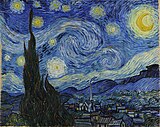
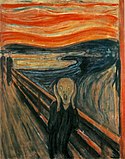

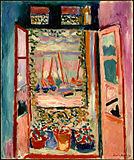

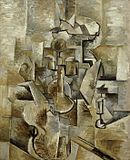






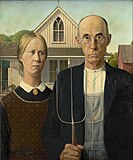



0 Response to "Which Painting Would Be Considered a Milestone in the Development of Modern Art?"
Post a Comment